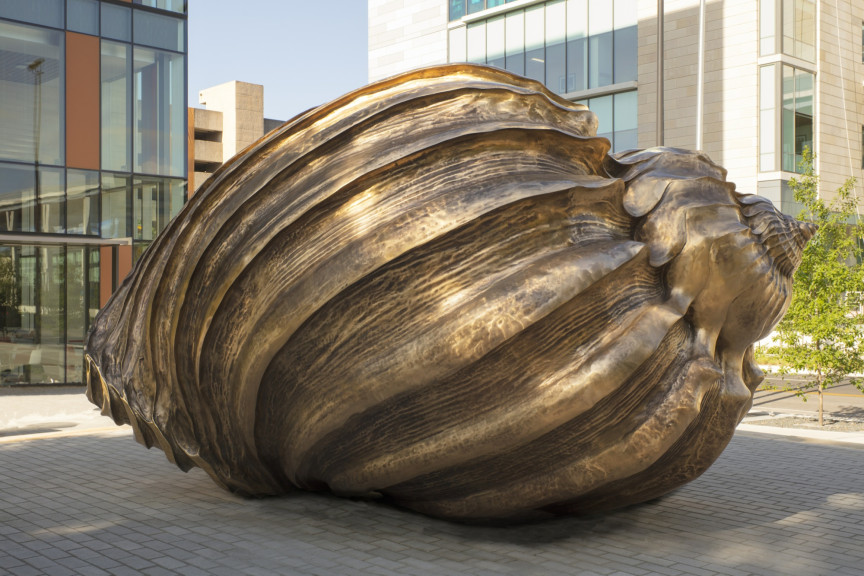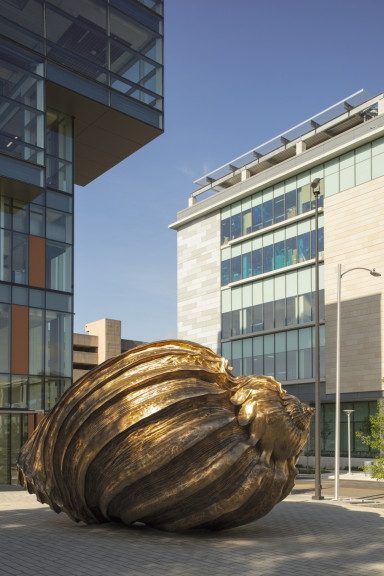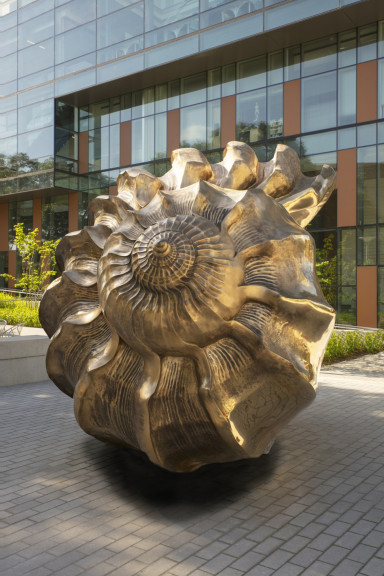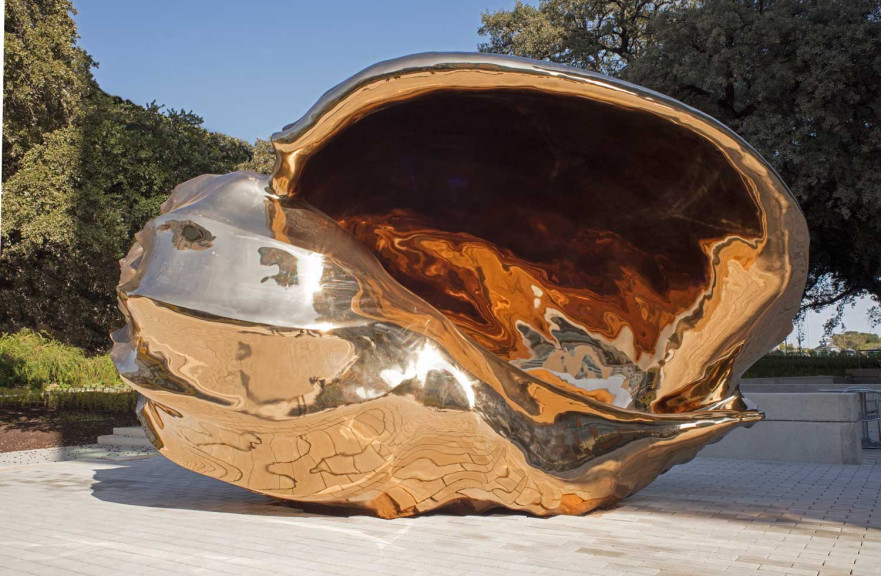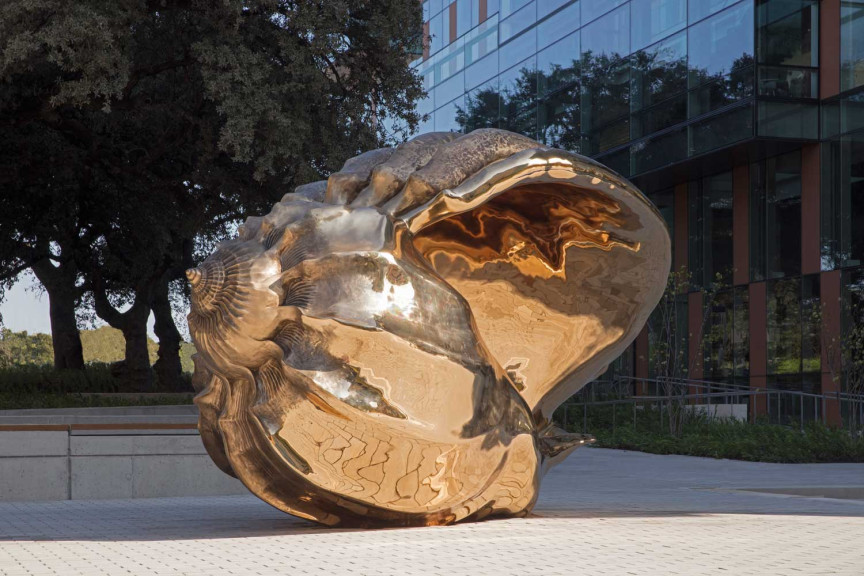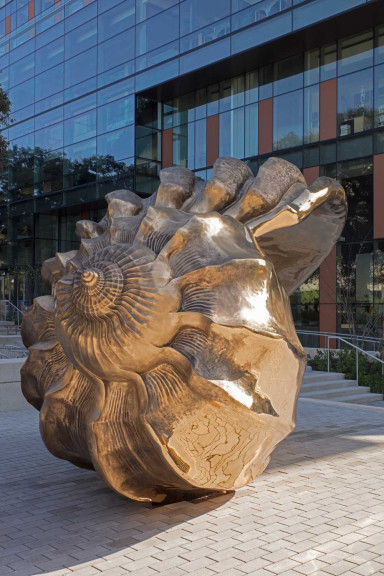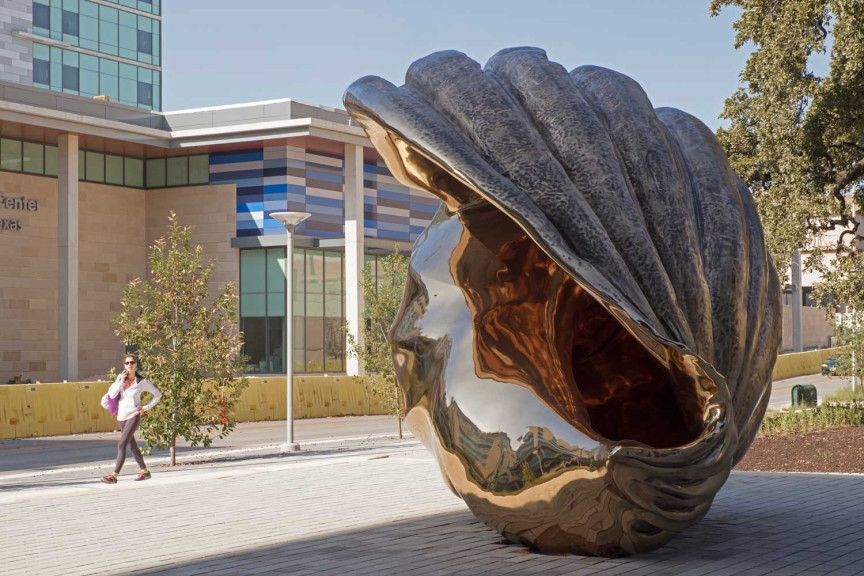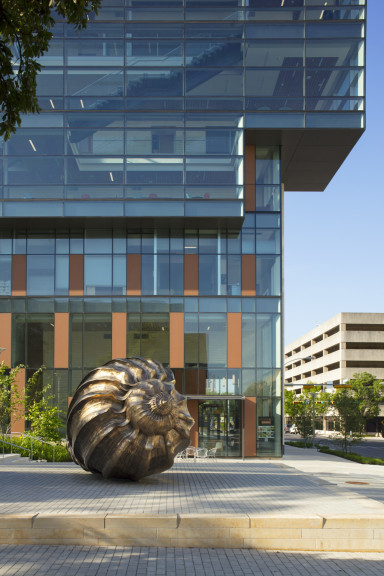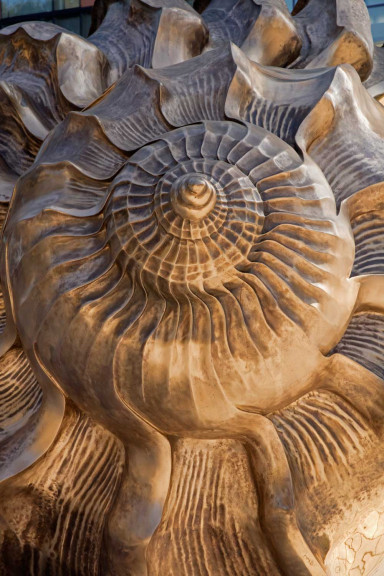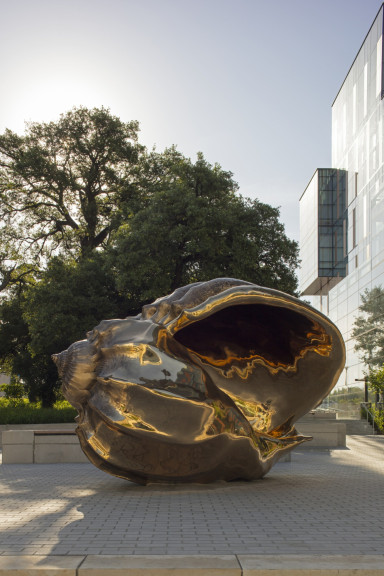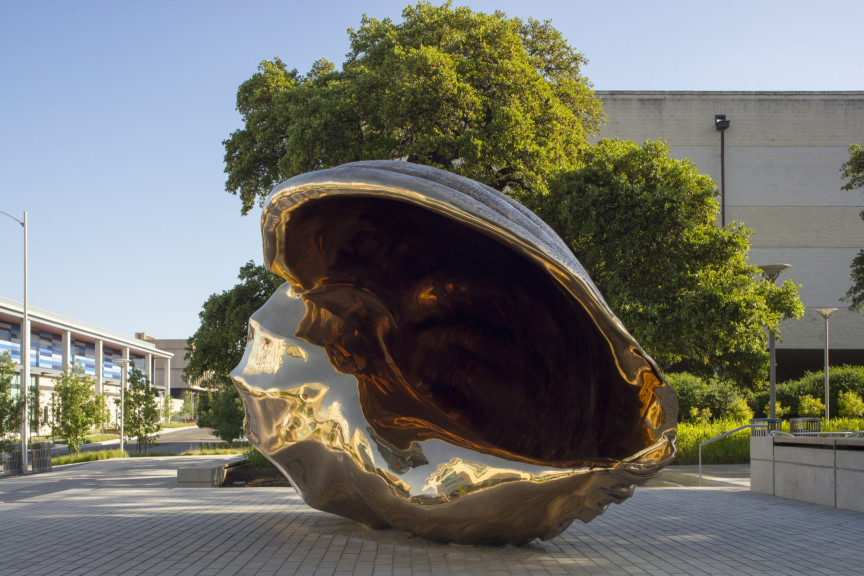Spiral of the Galaxy
Marc Quinn
131 x 196 x 100 inches
Purchase, Landmarks, The University of Texas at Austin, 2014
30.27586, -97.73336
In his sculptural series The Archaeology of Art, Marc Quinn creates monumental forms from seashells. The conch for Spiral of the Galaxy is based on a specimen in the British Natural History Museum collection. For Quinn’s work, the conch was scanned in three dimensions, then a mold was created and cast into bronze. The resulting figure is familiar in its proportion and surfaces, but strange because it no longer invites intimate handling. Its altered material and scale transform it into a solid, architectural form that occupies public space and interacts with the urban ecosystem.
Quinn first gained public attention in the early 1990s through his affiliation with the Young British Artists (YBAs). Among his earliest and most iconic works is Self (1991), a cast of his head made from ten pints of Quinn’s frozen blood, an amount equal to the volume in his body. In a 2013 interview, the artist described the YBA movement as focused on “bringing real life into art.” In both Self and Spiral of the Galaxy, Quinn’s impulse is holistic and metaphysical, translating the substance of life into image. Spiral of the Galaxy is easily recognized as a direct descendant of the small shell it models. However, by dramatically altering the material, scale, and surroundings, the shell acquires a mythical quality, quivering between reality and fantasy. Quinn has called seashells “the most perfect preexisting sculptural ‘readymades’ in our natural world,” referring not only to the graceful intricacy of their forms, but also to the wonder of their natural production.
The sliding scales along which a society measures fragility and strength, ephemerality and endurance, even life and death, are central concerns of Quinn’s art. Throughout his career, he has explored the unstable margins of life and the meanings we find in them: the vital interconnectedness of all life forms across time; the desire to still a passing moment or to live forever; and the aspiration to live in harmony with nature and other people.
ACTIVITY GUIDES

Spiral of the Galaxy
Marc Quinn
Subject: Form and shape
Activity: Aluminum foil sculptures
Materials: Aluminum foil, tape, cardboard
Vocabulary: Shape, texture, mold, bronze
Sculptures can be made from many different materials. Marc Quinn melted a metal called bronze and poured it into a mold of a shell to make Spiral of the Galaxy.
He polished the inside to make it smooth and shiny, just like a real shell.
What materials can be used to make a sculpture?
Describe the different textures you see.
How do you think the artist created the different textures?
Scrunch, crumple, and bend sheets of aluminum foil into different shapes. Can you make a figure of a boy or girl? What about a shell? Use the foil like clay and try to make many shapes and tape them together to create one large sculpture. Use more tape to attach your finished sculpture to the cardboard as a pedestal like Spiral of the Galaxy.
Set your new sculpture outside and see how it sparkles in the sunlight just like Spiral of the Galaxy!
Shape: A form like a circle, square, or triangle
Texture: The smooth or rough feel of a sculpture or painting
Mold: An empty form that can be filled with melted metal to create a sculpture
Bronze: A type of metal used in sculpture that has a golden color

Spiral of the Galaxy
Marc Quinn
Subject: Scale
Activity: Use a grid to make drawings bigger
Materials: A simple drawing, scissors, a large, square sheet of white paper, and pencil, crayons, or markers
Vocabulary: Scale, enlarge, grid, mold
When artists make a work of art they can change the size, color, or texture to give it special meaning. Changing the size, or scale, of something could make it more or less important than the objects around it.
Marc Quinn used a computer to make this conch shell larger than life! He scanned a real shell into the computer, then a 3D printer created large molds that were filled with melted bronze. Before computers, artists used simple tools like grids and rulers to make a picture larger or smaller.
Why do you think artists make something smaller or larger?
If you change the size of an object how does the meaning change?
If you could grow anything to be twice as big what would you choose?
If you could shrink something to fit into your pocket what would you choose?
Pick out a drawing you’ve made in the past. Pick one that is simple with big shapes and no colors or shading. Or make a new one! Trim the sheet into a square. Make a grid by folding the drawing in half four times. When you unfold it you should have 16 squares.
Fold the large sheet of paper in half four times to make a blank grid.
To enlarge your original drawing, look at the first section of the drawing and draw the same lines into the first section of the blank sheet. Try to make the two sections as similar as possible. Move on to the next section until you’ve filled the entire grid. Add color to finish the drawing!
Download the activity guide to see an example.
Scale: The size of an object compared to another object
Enlarge: To make an object bigger
Grid: Straight lines that cross each other to make a sheet full of same-sized squares
Mold: An empty form that can be filled with melted metal to create a sculpture

Spiral of the Galaxy
Marc Quinn
Subject: Sound and Environment
Activity: Write a poem inspired by the sights and sounds of Dell Medical School
Materials: Pencil, paper, and crayons, colored pencils, or markers
Vocabulary: Symbolize
This sculpture was chosen for the new Dell Medical School because of the special meaning behind conch shells. These shells are strong in order to protect the delicate sea snail that lives inside. In art, a conch shell can symbolize protection because of the sturdiness of the shell. It can also suggest life-giving because shells come from water, which is important for all living creatures to survive. Students who are studying to become doctors at Dell Medical School are protecting their patients just like the shell protects the sea snail.
What type of creature could live in this giant shell?
What other types of “houses” protect the creatures that live inside?
What do doctors do to make us feel better? What are some ways we can make each other feel protected and safe?
Discover the sights and sounds of Dell Medical School! Take a few minutes to look at all sides of the sculpture. Look at the surrounding buildings and landscape. What do you see?
If you put a real conch shell to your ear you can hear the sound of the ocean! What sound do you think this conch shell would make? Close your eyes and listen to the sounds around you. Do you hear students talking? Can you hear the engine of a car or the siren of an ambulance? What sounds do you hear from nature?
Write down three words to describe your observations. Use these to inspire a short poem. Trade words with a friend and write a poem inspired by your friend’s observations. Illustrate or decorate your poem!
Symbolize: giving an image, color, or object special meaning; the color red can symbolize love
MORE INFORMATION
A seashell is a mollusk’s exoskeleton. Washed ashore after the animal’s death, it appears as a jewel upon the sand—a protective shelter now exposed as vulnerable. Fortification for the mollusk, the shell can outlast the animal by thousands of years. And yet a sandy pulp of rocks and shells, formed over eons, squishes between the beachcomber’s toes.
In his sculptural series The Archaeology of Art, Marc Quinn transforms actual seashells into monumental forms. Spiral of the Galaxy, one work from this series, now finds a home in a public courtyard of the Dell Medical School at The University of Texas at Austin. The work is a massive bronze, ten feet high by fourteen feet long and weighing seven tons—an enlarged replica of a particular shell that Quinn once held in his hand. In it, the artist celebrates the magnitude of a delicate, natural world.
The sliding scales along which a society measures fragility and strength, ephemerality and endurance, even life and death, are central concerns of Quinn’s art. Throughout his career he has explored the unstable margins of life and the meanings we may find in them; the vital interconnectedness of all life forms across time; the desire to still a passing moment or to live forever; the prospect of living in harmony with nature and with other people. His work is fundamentally existential.
Among Quinn’s earliest and best-known works is Self (1991), a cast of his own head made from ten pints of his own frozen blood. This self-portrait as a revised classical bust not only represents the artist but also consists of him, here exemplifying the ways in which form and substance converge in his work to make meaning. Self depends on refrigeration to maintain its solidity, and therefore exists on a kind of life support, symbolizing life’s many dependences—a word that may be considered in more than one sense: Quinn was an alcoholic at the time. But the work also celebrates life’s vitality. The ten pints of blood constituting the sculpture equal the amount in Quinn’s body. For him, the head’s existence alongside his own signals the powerful regeneration of life.
Quinn first came to public attention in the early 1990s through his affiliation with the so-called Young British Artists, or YBAs. Now historical rather than descriptive, the label denotes a group of artists, then in or fresh out of art school, who exhibited together and appeared to flout artistic austerity in favor of shock value and publicity, with the further hope of sales. Yet we are still susceptible to YBA artists’ reinterpretations of realism and embrace of populism through relatable subject matter and a range of nontraditional materials. In a 2013 interview with curator Germano Celant, Quinn said that, for him, the YBA movement had been about “bringing real life into art.” In Self he achieves this, materially and thematically, as he does in Spiral of the Galaxy. Quinn’s urge is holistic and metaphysical, a desire to translate the substance of life into image.
But his work is motivated by the ethical as well. In his sculptural series The Complete Marbles, for instance, Quinn subverts Western ideals of “Beauty” and “Virtue.” Inspired in part by broken classical sculptures, such as the Venus de Milo, the series depicts people born without limbs or who have lost limbs through accident or illness. Made from direct molds of the subjects’ bodies in collaboration with traditional marble masons in Tuscany, the sculptures appropriate the authority of Neoclassicism to promote more inclusive views of humanity grounded in diverse bodies and life experiences. The culmination of this series, Alison Lapper Pregnant (2005), is a fifteen-ton monument created for public display. Lapper, an English artist born without arms and with shortened legs, appears in a dignified pose during her eighth month of pregnancy. Temporarily installed on the fourth plinth at Trafalgar Square in London—a site built in commemoration of British war heroes—the sculpture challenged people to examine and expand their own notions of both physical beauty and heroism.
As reported to Celant, Quinn believes that “beauty lies in reality, that it is beyond appearances and is about feeling contradictory emotions at the same time in a compelling way.” The apprehension of beauty, in this sense, is a dialectical process involving sensory and intellectual perception, emotion, and participation in the world; whatever it is, beauty is not idealized form isolated from life. Quinn’s view recalls the philosopher John Dewey’s influential treatise Art as Experience, which presents aesthetic experience as a qualitative intensification of life experience. For Dewey, as for Quinn, art lies not merely in the art object but rather manifests through the meaningful experiences of those who perceive it.
Spiral of the Galaxy, 2013
Quinn selected the shell for Spiral of the Galaxy from the British Natural History Museum collection and scanned it in three dimensions to create a digital image of its surface. This file then went to Belgium, where the manufacturing corporation Materialise produced a sculptural prototype through stereolithography, or 3D printing. Enlarged to the work’s final dimensions, the prototype required sectioning into several pieces before shipment to Spain, where the foundry Fademesa produced the mold and cast it in bronze. What results is a figure at once familiar and strange, as shifts in material and scale preserve details of the natural shell and yet transform its mode of inhabiting the world. No longer a delicate object inviting intimate handling, Quinn’s shell has become a solid, architectural form, now occupying public space and affecting the urban ecosystem.
On the medical school campus, Spiral of the Galaxy sits among a system of roads and buildings as well as cultivated green spaces with trees, benches, and some wildlife (Austin’s ever-present grackles and squirrels). Integrated with these surroundings and yet standing in deliberate contrast, the sculpture comes alive through one’s awareness of its interactions with the environment. What sound does the wind make passing over and across this massive bronze? How does its polished inner surface reflect the sky, greenery, buildings, or one’s own face? Such questions may lead to mindful interrogations of ourselves as well as a heightened sense of the ways we too are sited in this place, or even in the world.
The public space the sculpture inhabits is not only physical, however, but also social and discursive. What a community chooses to monumentalize, and how, tells us something about who they are or want to be. Traditional monuments not only portray sanctioned “heroes” but also instruct the public in how to understand them, through explanatory plaques or codified gestures that convey the figure’s cultural authority. Such monuments construct or reinforce public identity narratives in which both agents and manners of virtue arrive pre-prescribed. But, like his sculpture of Alison Lapper, Quinn’s monumental seashell seems to counter that tradition by asking us how we want to be, not telling us who we are. Seashells are ahistorical and acultural, as people across the world have marveled at their organic complexity for millennia; they carry no determinate values but simply are. By honoring the distinctive features of an individual specimen, Spiral of the Galaxy might challenge us to see value in the muteness of pure existence.
Spiral of the Galaxy is easily understood as a direct relative of the small shell it models. And yet through dramatic shifts in material, scale, and context, the work acquires a mythical aspect as well. Like photography or a surrealist readymade, Spiral shivers between the real and the fantastical, and Quinn has called seashells “the most perfect pre-existing sculptural ‘readymades’ in our natural world.” In this he refers not only to the intricacy of their forms but also the wonder of their natural production. As he told Celant, “there are so many amazing things to see in the world that we’ll never discover the end of it.” In Spiral of the Galaxy, the artist invites all to share in this bounty.
Here lies the work’s force, in its potential to affect perception, even possibly a person’s social consciousness. In the context of the medical school campus, some may see in the shell a symbol of the medical profession, as both are complex structures that protect delicate organisms. The first medical school built from scratch within a major academic institution, Dell aims to pioneer innovative cross-disciplinary research and community-driven wellness initiatives. Is it so far-fetched, then, to see the shell as a symbol of the extensive social and biological networks that connect individuals with their communities and the environment?
As Dewey said, “no creature lives merely under its own skin.” Non-human animals, for him, modeled a purity of integration among organisms and their environments basic to life as well as aesthetic experience. Life goes on through interaction with the environment, he observed, and thus every need signals a temporary disruption of that harmony requiring an adjustment to restore equilibrium. Life forms as well as cultures evolve by means of this tension and its resolution, as he said, and art brings that evolution to human consciousness for interpretation.
The seashell is a relic of the mollusk’s total integration with and responsiveness to its environment. Mollusks build their shells via layers of minerals and proteins secreted through their mantles. While environmental factors, such as lack of food, may temporarily halt this process, in good times it continues, and the shell expands to accommodate the animal as it grows. Recent research, led by University of California, Berkeley biophysicist George Oster, considers this mechanism neurological. Although the mollusk lacks a brain, its tongue-like mantle “tastes” the calcium carbonate in the prior layer before depositing the next one. In doing so, the animal acquires a memory of its past as it extrapolates to the next layer, like the way our brains project needs and circumstances into the future. In this way, seashells acquire their unique shapes and surface patterns—a biological process akin to the artistic.
Although Quinn made Spiral alongside several technical collaborators, he considers it a joint effort with the mollusk. “I’m collaborating with these tiny brainless creatures that live at the bottom of the sea, that make these unbelievable symmetrical forms,” he told Celant. “To me, it’s like looking at the archeology of art.” In emphasizing the aesthetic quality of the mollusk’s creation, Quinn yokes art with biological impulses that are normally the reserve of physical sciences. Dewey believed that a disharmony of modern life had resulted from a separation of supposedly material from supposedly mental or spiritual domains—including the artificial separation of art from ordinary life and scientific inquiry. Quinn’s brooding work harmoniously reintegrates these fundamental aspects of human experience.
Robin K. Williams is a doctoral candidate in art history at The University of Texas at Austin.
Celant, Germano, Robert Calcagno, and Marc Quinn. Marc Quinn: Memory Box. Milan: Skira, 2013.
Celant, Germano, and Marc Quinn. “About Change and Life.” In Marc Quinn: Memory Box, 9–33. Milan: Skira, 2013.
Quinn, Marc. Marc Quinn: Fondazione Giorgio Cini. Venice, 2013.
Quinn, Marc. Marc Quinn Fourth Plinth. Göttingen: Steidlmack, 2006.
Quinn, Marc. Marc Quinn: Selfs. London: Space, in collaboration with Foundation Beyeler, 2009.
Other Sources
Boettiger, A., Ermentrout, B., Oster, G., and Marder, E. “The Neural Origins of Shell Structure and Pattern in Aquatic Mollusks.” Proceedings of the National Academy of Sciences of the United States of America 106, no. 16 (April 2009): 6837–42.
Dewey, John. Art as Experience [1934]. New York: Capricorn Books, 1958.
Stewart, Susan. On Longing: Narratives of the Miniature, the Gigantic, the Souvenir, the Collection. Durham: Duke University Press, 1993.
Landmarks purchased Spiral of the Galaxy by Marc Quinn to anchor the gateway to the Dell Medical School. The conch carries cultural and religious significance, and among many interpretations can be seen here as a complex structure that protects delicate organisms.
Funding for the acquisition of Spiral of the Galaxy was provided by the capital improvement project for Dell Medical School. This project would not have been possible without generous assistance from many including:
Leadership
Andrée Bober and Landmarks
Pat Clubb and University Operations
Douglas Dempster and the College of Fine Arts
Gregory Fenves and the Office of the President
Clay Johnston and Dell Medical School
Landmarks Advisory Committee
Bob Rawski and the Office of Facilities Planning and Construction
David Rea and the Office of Campus Planning and Facilities Management
Frederick Steiner and the Campus Master Planning Committee
Project Team
Nisa Barger, project manager, Landmarks
Andrée Bober, curator and director, Landmarks
Karel Kozeh, Office of Facilities Planning and Construction
Hansel Phelps
Marc Quinn, artist
Page Sutherland Page
Sasaki and Associates
Patrick Sheehy and Vault Fine Art Services
Special Thanks
Mary Boone, Mary Boone Gallery
Deb Duval, event coordinator
Gilles Heno-Coe, collections management, Landmarks
Masterpiece International
Nick Nobel, external affairs, Landmarks
Jim Oliver, Mary Boone Gallery
Bill Simpson, Office of Facilities Planning and Construction
Damian Smith, Marc Quinn studio
Larry Speck, School of Architecture
Stephanie Taparauskas, development, Landmarks
Amanda Tofflemire, Dell Medical School
Jennalie Lyons, development, Landmarks
Ron Warren, Mary Boone Gallery
Robin K. Williams, curatorial contributor
Misa Yamamoto, College of Fine Arts
Catherine Zinser, education, Landmarks

